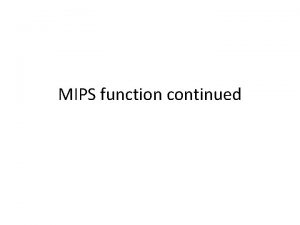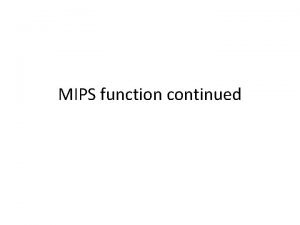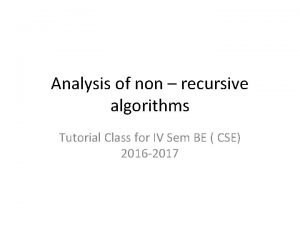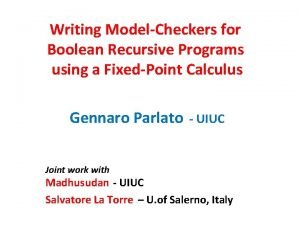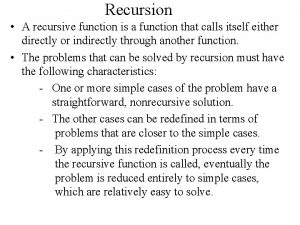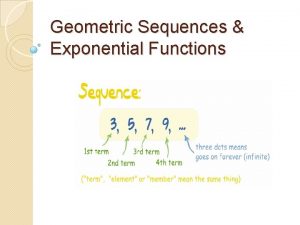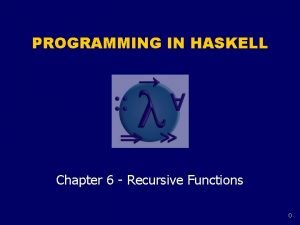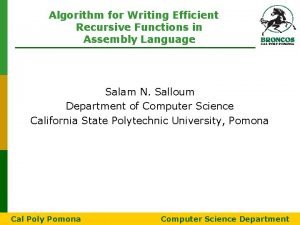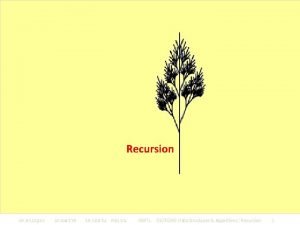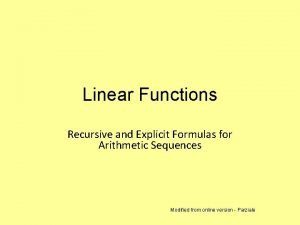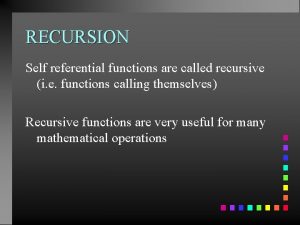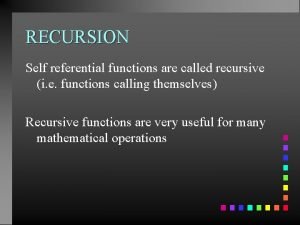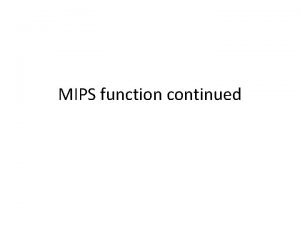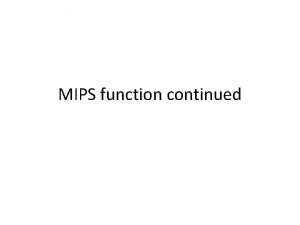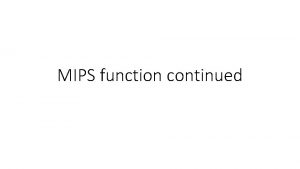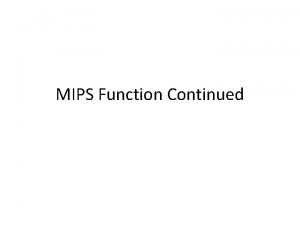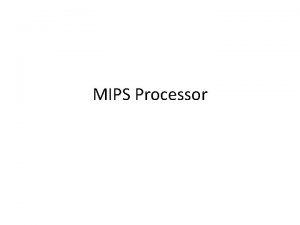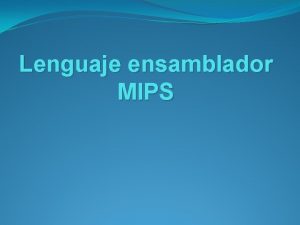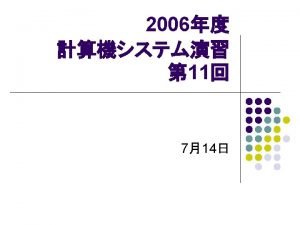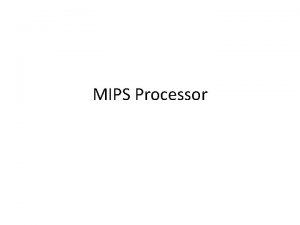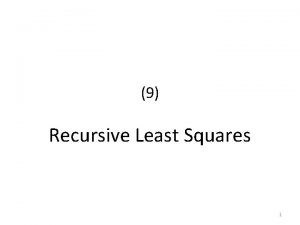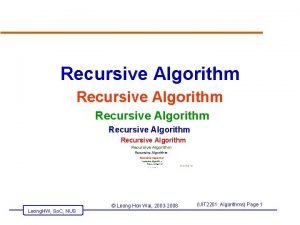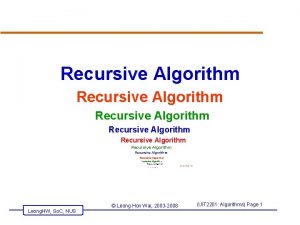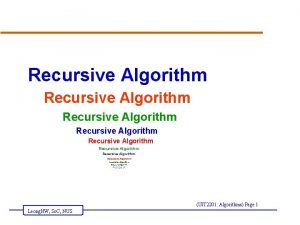MIPS function continued Implementing a Recursive Function Suppose















- Slides: 15

MIPS function continued

Implementing a Recursive Function • Suppose we want to implement this in MIPS: • It is a recursive function – a function that calls itself. • It will keep on calling itself, with different parameters, until a terminating condition is met.

The Recursive Function • What happens if we call fact(4)? – First time call fact, compare 4 with 1, no less than 1, call fact again – fact(3). – Second time call fact, compare 3 with 1, no less than 1, call fact again – fact(2). – Third time call fact, compare 2 with 1, no less than 1, call fact again – fact(1). – Fourth time call fact, compare 1 with 1, no less than 1, call fact again – fact(0). – Fifth time call fact, compare 0 with 1, less than 1, return 1. – Return to the time when fact(0) was called (when calling fact(1)). Multiply 1 with 1, return 1. – Return to the time when fact(1) was called (when calling fact(2)). Multiply 2 with 1, return 2. – Return to the time when fact(2) was called (when calling fact(3)). Multiply 3 with 2, return 6. – Return to the time when fact(3) was called (when calling fact(4)). Multiply 4 with 6, return 24.

The Recursive Function • In MIPS, we say calling a function as going to the function. So we go to the function over and over again, until the terminating condition is met. • Here, the function is called “fact, ” so we will have a line of code inside the fact function: jal fact

The Recursive Function • The parameter should be passed in $a 0. In the C function, every time we call fact, we call with n-1. So, in the MIPS function, before we do “jal fact”, we should have “addi $a 0, -1. ” addi $a 0, -1 jal fact

The Recursive Function • After calling fact, we multiply the return result with n, so addi $a 0, -1 jal fact mul $v 0, $a 0

The Recursive Function • After multiplying, we return, so addi $a 0, -1 jal fact mul $v 0, $a 0 jr $ra

The Recursive Function • So, one if else branch is done. The other branch is slti $t 0, $a 0, 1 beq $t 0, $0, L 1 ori $v 0, $0, 1 jr $ra where L 1 is where we should go to if n >= 1.

The Recursive Function fact: slti $t 0, $a 0, 1 beq $t 0, $zero, L 1 ori $v 0, $0, 1 jr $ra L 1: addi $a 0, -1 jal fact mul $v 0, $a 0 jr $ra Any problems?

The Recursivefact: Function • The problem is that the function will call itself, as we have expected, but it will not return correctly! • We need to save $ra, because we made another function call inside the function. We should always do so. • Is this enough? addi $sp, -4 sw $ra, 0($sp) slti $t 0, $a 0, 1 beq $t 0, $zero, L 1 ori $v 0, $0, 1 lw $ra, 0($sp) addi $sp, 4 jr $ra L 1: addi $a 0, -1 jal fact mul $v 0, $a 0 lw $ra, 0($sp) addi $sp, 4 jr $ra

The Recursive Function • So now we can return to the main function, but the return result is 0, why? • A call to fact modifies $a 0. But when we return from a call, we multiply it with $a 0! • So, should also save $a 0! • Restore it before using it again.

. data. text. globl main: li $a 0, 4 jal fact done: li $v 0, 10 syscall fact: addi $sp, -8 sw $ra, 4($sp) sw $a 0, 0($sp) slti $t 0, $a 0, 1 beq $t 0, $zero, L 1 ori $v 0, $0, 1 addi $sp, 8 jr $ra L 1: addi $a 0, -1 jal fact lw $ra, 4($sp) lw $a 0, 0($sp) mul $v 0, $a 0 addi $sp, 8 jr $ra

The Stack During Recursion 2/27/2021 week 04 -3. ppt 13

Two other MIPS pointers • $fp: When you call a C function, the function may declare an array of size 100 like int A[100]. It is on the stack. You would want to access it, but the stack pointer may keep changing, so you need a fixed reference. $fp is the “frame pointer, ” which should always point to the first word that is used by this function. • $gp: the “global pointer. ” A reference to access the static data.

A: . data. word 0, 1, 2, 3, 4, 5, 6, 7, 8, 9 . text. globl main: la $a 0, A li $a 1, 6 li $a 2, 5 jal on. Up. Stream done: li $v 0, 10 syscall Solution to the in class exercise # exit on. Up. Stream: lw $t 0, 0($a 0) beq $t 0, $a 1, on. Up. Stream_NO beq $t 0, $a 2, on. Up. Stream_YES addi $a 0, 4 j on. Up. Stream_YES: ori $v 0, $0, 1 j on. Up. Stream_DONE on. Up. Stream_NO: ori $v 0, $0, 0 on. Up. Stream_DONE: jr $ra
 How to do recursion in mips
How to do recursion in mips Mips recursive function
Mips recursive function Example of non recursive algorithm
Example of non recursive algorithm Recursive boolean function
Recursive boolean function Recursive algorithms
Recursive algorithms Why geometric sequences are exponential functions
Why geometric sequences are exponential functions Haskell recursive function
Haskell recursive function Risc v fibonacci recursive
Risc v fibonacci recursive Tower of hanoi python
Tower of hanoi python Explicit formula
Explicit formula Recursion
Recursion Recursive function
Recursive function Hrd program implementation
Hrd program implementation Management issues central to strategy implementation
Management issues central to strategy implementation Implementing strategies management and operations issues
Implementing strategies management and operations issues Chapter 7 strategic management
Chapter 7 strategic management
